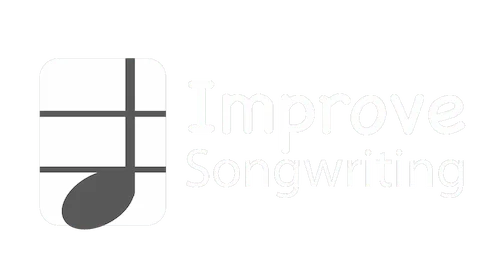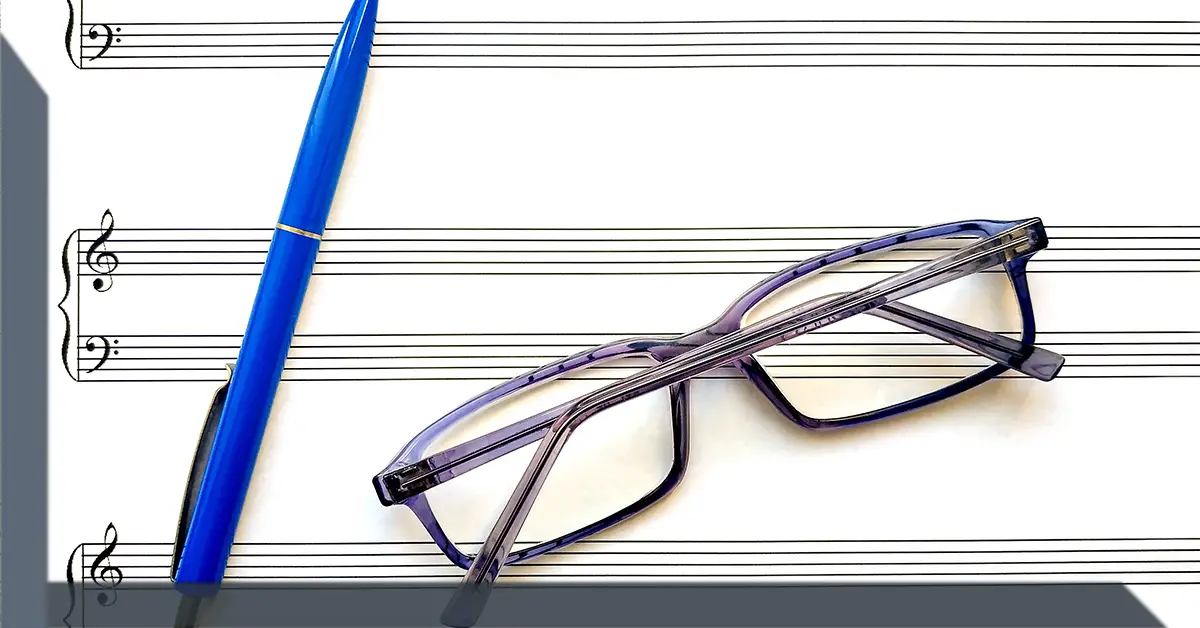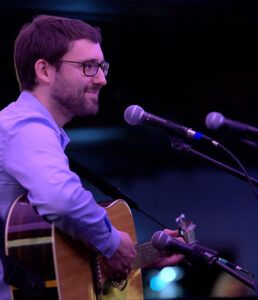When it comes to writing a new song, you obviously need to know about musical elements like chord progressions, rhythm, tempo, and so on. But at a deeper level, your first task is to understand the 7 different parts of a song that can make up its structure.
Why?
Well, just like you (hopefully!) wouldn’t try to assemble that new IKEA end table without understanding the pieces you’re working with, you wouldn’t attempt to write an entire song without knowing all the different parts at your disposal. Right?
So, in this epic guide, we’ll talk about each of these 7 different parts of a song in order – plus the 4 common song structures that use them – so you have everything you need to write better songs!
Improve your songwriting by mastering piano.
$49
ONLY
The 7 Parts of a Song
Our first step in understanding how to structure a song is to learn about the 7 common parts of a song. You can mix and match these to create interesting song structures that fit the song you’re working on.
While people may categorize or define them in slightly differently ways, here’s my list of the 7 essential building blocks of modern popular songs:
Now, this doesn’t mean you can’t toss these sections aside and do whatever you want in a song, but understanding them and how they work can only HELP you write more accessible songs – there’s a sense of familiarity to songs built from these sections as a foundation.
With that said, here’s a look at each one and how they function as part of the greater whole!
1) Intro
Songs have to start somewhere, don’t they?
A lot of tracks just bypass the intro and jump right into a verse or chorus, but in other cases, songs will have a dedicated intro of 2, 4, or even 8 bars!
In our post on “song intro ideas,” we talk about Eminem’s “Lose Yourself,” which has a melancholy instrumental piano part that ONLY takes place in the intro – you don’t hear it again at all throughout the rest of the song.
In reality, the intro might be a few bars of the main instrumental hook, a few strummed chords, or even a spoken intro (like in T.I.’s Whatever You Like). Another common intro trope is the main riff or chorus backing track, but with the drums removed. This allows for a buildup, a big drum fill, and then an exciting resolution when the full drum part kicks in!
So, why should you have an intro to your song?
Well, you don’t necessarily need it…
Many songs don’t have a dedicated, unique intro, especially today. In decades past, your song would have a musical intro to give the radio DJ a chance to finish reading off his script while the song fades in. Intros also help transition between two songs on an album where one plays before the other!
But in the age of streaming, having an intro is much more about artistic taste and less about these practical concerns.
2) Verse
Ah, the song verse. Please allow me to wax poetic about the single most creative part of the song. Yes, it’s the verse – not the chorus – where most of the creativity lies.
Why?
Because verses are the parts of a song that exist in the sweet spot between repetition and novelty. Choruses are built to repeat and bridges are one-time use, but the verse splits the difference: your second verse will sound a lot like your first, but it will likely be substantially different.
Choruses are like French fries: they’re great, even after you’ve already enjoyed a few. And bridges are like ketchup: a nice addition in contrast to the french fry, but you wouldn’t want to eat much ketchup on its own.
Verses are like fries and ketchup together: enough that’s the same to be comfortable, but enough that’s different to add some nice flavor.
Depending on who you ask, every song with lyrics has a verse. After all, verses are basically the default structural component of any song. So, if you’re writing a song, you’re definitely going to have a couple of verses.
However, it can sometimes be difficult to nail down the exact definition of a verse!
There is no universally accepted rule for what a verse is. But here are some rules of thumb for distinguishing verses from other parts of a song:
- Intros, bridges, and outros only appear ONCE by definition, but the verse repeats at least a few times in a song.
- Pre-choruses and post-choruses tend to stay the same and only last a few bars, while verses are usually more variable lyrically and tend to be 8 or 16 bars.
- For most intents and purposes, a pre-chorus or post-chorus can be considered extensions of a verse (or a chorus).
Finally, the easiest way to tell the difference between a verse and a chorus is that the chorus tends to repeat with the same music and lyrics, while the verse changes its lyrics.
But there are subtler things to look for…
For example, the hook in a song tends to be in the chorus, which means the surrounding sections are probably a song’s verses. Another clue: verses tend to move stories along, while choruses tend to reflect on a moment or concept!
3) Pre-Chorus
Most songs follow a basic structure that involves alternating verses and choruses. But sometimes, you need another song element to split the two up: the pre-chorus.
It might be for dramatic reasons, breaking up two high-energy sections with a short, slow one to build up the sense of anticipation. It could be for musical reasons, using a few bars to set up for a key change.
But what’s for certain is that if you have a few bars after the verse and before the chorus that feel like a transition, that’s a pre-chorus.
Not every song needs a pre-chorus. That said, they’re a wonderful tool for building interest as you move from your verse to your chorus.
Take a look at The Killers’ “Mr. Brightside.”
The verse is fast-paced, but slows down during the pre-chorus. Simultaneously, the wall of sound behind the vocals start to build. It accumulates, then drops out for the last lines of the pre-chorus, only to return dramatically for the chorus.
Beautiful! Powerful! Unforgettable!
4) Chorus
Here it is: the big event!
More often than not, this is the part of a song that will stick with your listener forevermore. The chorus is the most likely place for your song’s hook – and the title of the song – to appear.
Choruses usually convey the main message or theme of the song.
Think of a song like a play: parts of the song like the intro and verse deal with exposition and moving action. But the chorus is an opportunity for the speaker to have an “aside” with the audience and tell them how they REALLY feel. A good chorus gets across the feeling that the song is supposed to get across, both through lyrics and music.
Because it’s the central idea of the song, choruses tend to repeat as well.
Sometimes, the verse or bridge in between can help paint the chorus in a new light each time it comes up.
For instance, the rumour (or as Americans would write it, rumor) in Adele’s “Rumour Has It” changes with each verse, but the chorus stays the same.
Before we move on from the chorus, we ought to talk about the difference between a chorus and a refrain. The distinction is subtle, but it essentially comes down to how attached the chorus is to the verse.
Musically, most choruses are distinct from the sections around them. They might feature a key change, new instrumentation, or even a dramatic pause during transitions – but a refrain is simply appended to the end of a verse.
A great example is Bob Dylan’s “Blowin’ In The Wind.”
Every verse ends with the same two lines:
“The answer, my friend, is blowin’ in the wind
The answer is blowin’ in the wind”
It then returns to the next verse. These two repeated lines at the end of each verse make up the refrain.
And that’s it for choruses. I’d include a link to a song with a good chorus… but I think you probably can think of one yourself.
If you can’t, try literally any song ever.
5) Post-Chorus
Sometimes a chorus is so good, you don’t want it to end!
That’s where a post-chorus comes in. Post-choruses can be harder to spot than their pre-chorus cousins, but they’re out there. Often, post-choruses are filled with nonsense syllables that are meant to get stuck in your head. 
A great example of a post-chorus is Rihanna and Jay-Z’s “Umbrella.” After singing a fairly long chorus and saying the title, Rihanna doesn’t stop: she repeats “Umbrella (ella, ella, eh, eh, eh)” a few times.
That’s the post-chorus (orus, orus, or, or, or).
A lot of songs also have purely musical post-choruses after their chorus before they get into the next verse. Think of the cool riff that plays after each chorus in “The Boys Are Back in Town” by Thin Lizzy.
6) Bridge
Bridges are easy to identify. Here’s one right now:

Just as a bridge over a river connects the two sides, the bridge of a song connects two parts that are distinct from each other. A bridge in a song is really any section that is difficult to classify in a different category. In general, the bridge makes a one-time appearance within a song, usually anywhere from 50% to 75% of the way through.
Sometimes, the bridge might be the most iconic part…
Think of Outkast’s “Hey Ya!”. While the hook might get stuck in your head, it’s hardly had the cultural influence that “Shake it like a Polaroid Picture” has.
Bridges are so diverse that we have to break them down into a few different sub-categories!
Solo
Ahhhh, yeeeeeeah! It’s solo time!
When your band wants to show off someone’s awesome musicianship, the solo is where that can happen. Take a listen to this solo in Black Sabbath’s “Paranoid”:
Solos are even less clearly defined than bridges. Any non-standard, non-repeating piece of music, especially with a focus on one instrument, can be a solo.
Middle 8
Middle 8s are a specific type of bridge that usually serves as a turning point in the story. You’ll usually find a key change during or after a Middle 8 because it represents the change happening in the song’s narrative.
Quick note for the sticklers out there: A Middle 8 does NOT have to be in the center of a song, nor does it have to be exactly 8 bars long!
Like a bridge, a Middle 8 can have a different rhythm, melody, and accompaniment than the verse, chorus, or any other part off the song. But what really dinstinguishes Middle 8s is that a Middle 8 tends to connect one chorus to another, whereas a bridge doesn’t necessarily do that.
Here’s a very famous Middle 8 from Otis Redding:
And now for a brief interlude…
Interlude
Interludes are like very small solos that transition between sections of songs. They’re like extremely short bridges, though they might repeat. A great example is Living Colour’s “Cult of Personality.”
I’ve marked it here – after the chorus, there’s an instrumental riff that leads into the actual post-chorus (which itself leads into the actual guitar solo).
7) Outro
The outro is the ending of the song. It can be its own new musical idea, but it’s most often just a bombastic version of the chorus. It usually brings back other tags or hooks from earlier in the song, while also including elements not heard before to bring everything home.
In the old days, songs often faded out while the band played on. That sort of outro is less popular these days, but that doesn’t mean outros themselves are less popular.
On the contrary, I’d wager more songs have outros than proper intros today – because you need the intro to hook people immediately, but after they’ve been listening a while, you can afford to get more creative with your outdo!
Some songs have purely musical outros (the Red Hot Chili Peppers song “Slow Cheetah” has nearly a minute of music after the last lyrics is sung).
Other songs reuse their own lyrics – take Adele’s “Rolling in the Deep.”
She sings:
But you played it –
You played it –
You played it –
You played it to the beat.
By repeating the last line of her chorus, she creates an outro that sticks with the listener as the song comes to a close on the last beat.
A good outro is your song’s last impression. Make it a good one!
Basic Song Structure for Pop Songs
There are all kinds of songs out there that sound totally different from each other, but if you pay attention, you’ll realize that 99% of them are using some combination of the 7 parts of a song I discussed earlier.
For real.
Unless you’re poking around the weirdest part of the hipster record store in your own, or the jazziest of jazz clubs, you’re bound to hear songs that consistent of some combination of an intro, verse, pre-chorus, chorus, post-chorus, bridge, and outro.
Now, pay close attention to this.
The “default” song structure for any pop song is as follows:
Verse – Chorus – Verse – Chorus – Bridge – Chorus – Chorus/Outro
If all you did was just write songs using this format, you’d be fine at least 90% of the time.
Employing Theme and Variation
Of course, to understand how structure really works, you should first understand the “push and pull” that happens in songs to capture attention. This is broken down into:
- Theme
- Variation
The “theme” is your default musical idea, while the “variations” are what keep things interesting throughout the duration of a song.
For example, a typical song structure will establish the theme with a simple intro, verse, and chorus, and then vary things up with a bridge, subsequent choruses, and an outro.
These later sections layer in brand-new elements to establish contrast (i.e. variation). Sometimes, they’ll sound completely different, but they’re usually just different enough to stand on their own while maintaining familiarity that evokes your theme.
The point is, your choice of song structure plays a key role in how these themes and variations occur in your song. Use the 7 parts of a song carefully to heighten the message you want to convey!
4 Common Song Structures with Examples
Now, you can find countless examples of successful songs that follow the “default” structure I just mentioned. And if you’re looking for a place to start, it’s hard to go wrong with that one!
However, today’s songs tend to have pre-choruses and post-choruses a lot more than past songs did, because each of these is an additional opportunity to keep listeners engaged with strong hooks.
To illustrate a wider range of song structures, I’ve chosen a quick selection of pop songs. Each song uses a unique combination of the songs parts above.
But even though none of them use the EXACT same structure, the cool thing is, ALL of them are well-loved songs in their own right! Check it out.
“Brave” by Sara Bareilles
The song “Brave” by Sara Bareilles uses a very straightforward song structure that’s very close to our “default” structure. The only thing that stands out here is a post-chorus after the first chorus.
Verse – Chorus – Post-chorus – Verse – Chorus – Bridge – Chorus – Outro
Like many pop songs, the chorus after the bridge is a quieter, stripped-down arrangement that bursts into a full triumphant outro.
Also of note: the outro is essentially the post-chorus hook on repeat, but it also pulls in the main chorus hook, plus some other varied elements that end the song on a powerful note.
“Cake by the Ocean” by DNCE
The song “Cake by the Ocean” by DNCE is another one that doesn’t stray too far from the standard song structure, but adds in a pre-chorus to build momentum for its huge chorus.
Verse – Pre-chorus – Chorus – Verse – Pre-chorus – Chorus – Post-chorus – Interlude – Chorus – Outro
The song also features a one-time post-chorus that transitions into a brief interlude (it’s not really a full bridge), before jumping back into the chorus. By the time we hit the outro, DNCE has a totally new hook there to bring us home, but still drops in the primary chorus hook as well.
“Shape of You” by Ed Sheeran
The song “Shape of You” by Sheeran is one of the most popular songs ever made, at least if you go by number of streams on Spotify and YouTube (or by its endless airplay on terrestrial radio in 2017).
This one goes even farther than the previous two examples in squeezing a hook into every possible moment, with unique sounds featured in its pre-chorus, post-chorus, bridge, and outro.
Intro – Verse – Pre-chorus – Chorus – Post-chorus – Verse – Pre-chorus – Chorus – Post-chorus – Bridge – Chorus – Outro
It starts with an instrumental intro of its main riff, which plays under most of the song and adds stability between sections. But because of that consistency in the accompaniment, Sheeran can switch up the melody every few bars to keep the listener’s attention.
The song ends by pulling in the hook from the bridge for its outro.
“People Are Strange” by The Doors
The song “People Are Strange” by The Doors is a great example of a really simple song structure. With a running time of just 2:10, this song doesn’t overstay its welcome. You can easily break it down to just two verses and two choruses, plus a few small instrumental breaks.
Verse – Chorus – Interlude – Verse – Chorus – Solo – Outro
Does this mean simplicity is bad? Not at all!
The song has several compelling hooks running in tandem, and it honestly doesn’t need tons of extra sections to get its point across.
EDM Song Structure
I also wanted to point out the structure for an electronic (EDM) song.
This one is treated a little differently than the standard pop song, because it’s all centered around the idea of a bass drop.
Intro – Riff/Hook – Crescendo/Drop – Riff/Hook – Outro
Note that whether you have lyrics in your EDM song or not, a good song usually has a song structure with repeating elements that you can single out. If it’s not a “verse” and “chorus,” then it’s instrumental riff or hook A, followed by instrumental riff or hook B!
But the same logic applies.
Songs Without a Common Structure
Did you know that it’s possible to have a successful song that doesn’t follow the typical pop song structure? (Including some that lack any repeating elements at ALL?)
Generally, this means that they lack a repeating chorus. A lot of “rock operas” come to mind, such as “November Rain,” “Bohemian Rhapsody,” “Jesus of Suburbia,” and “Welcome to the Black Parade.”
Of course, even songs that appear to be “structureless” do have a structure of SOME kind. They may almost feel like a series of smaller songs strung together in a cohesive way – and this is often used in narrative songs that are focused on telling a story.
And songs that are “through-composed” might return to a familiar idea as well. Take Billy Joel’s “Scenes from an Italian Restaurant.” It returns to the “a bottle of…” section a few times.
I think it’s worth analyzing some of these songs without traditional structures to figure out why they made the creative decision to break with convention. Is there a thematic reason?
Conclusion
Applying these 7 elements of a song into your songwriting is like a baker experimenting with the different ingredients used in a cake. You can mix and match how much butter, flour, eggs, sugar, and vanilla you use in a recipe to discover entirely new structures that make your creation unique.
But in the end, your goal should be to make these parts of a song work together to support your vision for the song.
You’d be surprised how many exciting combinations of song structures there are out there, all broken down into these different song parts.
The only question is, which ones will YOUR next song use?
If you want to get better at writing memorable music that resonates, I recommend that you get familiar with an instrument like piano. The more you know about how great songs are constructed sonically, the easier it will be for you to create a masterpiece yourself. Check out Piano for All below to get started!
Improve your songwriting by mastering piano.
$49
ONLY



![What Is a Pre-Chorus? [And How to Write One!]](https://improvesongwriting.com/wp-content/uploads/2024/11/What-is-a-Pre-Chorus-440x264.jpg)

![Why is Songwriting So Hard? [The 3 Top Reasons]](https://improvesongwriting.com/wp-content/uploads/2019/09/Why-is-songwriting-so-hard-440x264.jpg)



